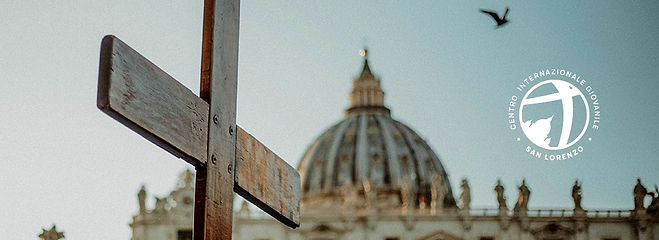
THE CROSS OF THE YOUTH
In the Basilica of St. Peter, there was, surprisingly, no cross that stood out prominently. Thus, on the occasion of the Extraordinary Holy Year of Redemption (1983-1984), the Holy Father wanted to place a very simple one next to the altar. On April 22, 1984, at the closing of the Holy Year, the Pope entrusted this Cross to the young people with these words: "Dear young people, at the end of the Holy Year, I entrust to you the sign of this jubilee year: the Cross of Christ! Carry it into the world as a sign of the Lord Jesus' love for humanity, and proclaim to everyone that only in Christ, who died and rose again, is there salvation and redemption."
The young people of the San Lorenzo Center, to whom Saint John Paul II entrusted the Cross, took this invitation literally. The Cross was solemnly carried in procession to the Church of San Lorenzo to be venerated there, and even today, this remains its home during the pauses in its many pilgrimages around the world. That same year, the Cross was taken to Munich, Germany, and then to Prague by Cardinal Tomášek. Since then, the Cross has traveled to every continent and has always stood beside the altar during World Youth Days.
The Cross is a powerful sign of God's incarnation in human life and suffering. The Cross without the crucified Christ, that is, without Jesus, also symbolizes the hope of resurrection and eternal life in the communion of saints. For this reason, the sign of the Cross belongs to all Christian Churches, and from an instrument of torture and death, it has become a sign of unity and hope for all Christians.
During the Angelus prayer on April 13, 2003, Palm Sunday, on the occasion of the twentieth anniversary of the San Lorenzo International Youth Center, as the Cross was being passed from the Canadian youth to the German youth, the Holy Father John Paul II recalled that San Lorenzo is the official home of the Cross with these words:
« I entrusted this Cross to the young people during the Holy Year of 1984. At the end of each pilgrimage, it is welcomed at the San Lorenzo Youth Center. I thank Cardinal Stafford, President of the Pontifical Council for the Laity, and his collaborators for their attentive care of the Center, as well as the Movements, Associations, and Communities that contribute to its animation, coordinated by the Emmanuel Community. »
A few days earlier, during a meeting with the youth of the Diocese of Rome, Saint John Paul II had identified four significant places for the preparation of World Youth Day :
«For this reason, I also wish that this Day [the 20th World Youth Day in Cologne in 2005, editor’s note] be prepared from today with constant prayer, which should rise from the entire Church and, in particular, in Italy, from four significant places: the Marian Shrine of Loreto and that of Our Lady of the Rosary in Pompeii; here in Rome, the San Lorenzo Youth Center, which for twenty years, just a few steps from St. Peter’s Basilica, has welcomed young pilgrims to the Tomb of the Prince of the Apostles; and the Church of St. Agnes in Agone, in Piazza Navona, where since the Holy Year of 2000, every Thursday evening, young people can find an oasis of prayer before the Eucharist and the opportunity to receive the sacrament of Confession».
In 2005, the Pontifical Council for the Laity produced an album in five languages (Italian, English, French, Spanish, German), illustrated with numerous photographs and texts tracing the vocation and history of the World Youth Day Cross from its origins to 2005, as well as a DVD containing two films (one of 5 minutes and another of 50 minutes). These are available free of charge upon request.
